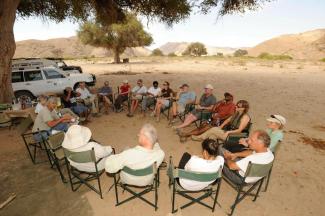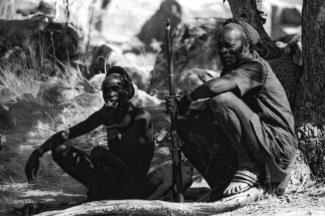Community conservation grew out of the recognition that wildlife and other natural resources are of value in communal areas, and that these resources can be unlocked if local communities are empowered to manage and utilise resources themselves.

Communities
Living with wildlife – sustainably
By choosing to live with wildlife, rural communities are broadening their livelihood options as well as enabling a healthier environment.
Community conservation in Namibia means rural people managing their natural resources sustainably to generate returns. Conservancies, community forests and other community conservation initiatives create the necessary legal framework for this.
Conservancy chairperson Judy Melekie
//Huab Conservancy in Kunene Region is close to the tourism routes and has income from a joint venture with a lodge, and from conservation hunting.
“As a woman,” says Melekie, “we sometimes underestimate our strength.” Empowering women in rural communities is very much part of the conservation agenda. Melekie says that she has managed to build up the conservancy finances and to employ the first female game guard at //Huab. Under her chairpersonship a mobile campsite has been set up and the conservancy won a best practice award for the protection of rhino.
Drought and wildlife crime are the two major dangers for //Huab, but Melekie is confident that with income from conservation hunting the conservancy will be able to keep up its anti-poaching patrols and to maintain its wildlife.
» Read more about women in leadership.

Conservancy chairperson Abedi Kaiko

Otjombinde Conservancy is in Omaheke Region, bordering Botswana. It is an area of sparse vegetation close to the Kalahari Desert, that can support limited livestock. Kaiko says there is “a lot to be done”.
The first challenge is setting up an office. From there, Kaiko wants to build up conservation awareness in the community to conserve what is there for future generations. Part of that work will be to demarcate a core wildlife area.
Meeting with other conservancy chairpersons at a national level in the Conservancy Chairpersons’ Forum was very valuable to Kaiko. He learnt from others about the importance of financial management. Otjombinde does not have a great deal of wildlife, but the conservancy makes common cause with others to oppose potential bans on conservation hunting, because this brings income that can be used for conservation, leading to sustainable wildlife populations.
Conservancy manager Hilde Nathinge
Sheya Shuushona Conservancy lies directly north of Etosha National Park. It has a limited income due to the lack of tourism, although a joint-venture with a private sector lodge is planned.
Nathinge is proud of the conservancy’s record of compliance with the MEFT’s Standard Operating Procedures. “Everything is in order,” she says.
In the past, says Nathinge, women had no say in decision making. All that has changed. She compiles the financial and annual reports, and manages the staff, including game guards, who she calls “the backbone of the conservancy.”
The founding President came from the area, and Nathinge says that the spirit of liberation is still alive. “If we keep working hard we will see the fruits of our labour.”
» Read more about women in leadership.

Conservancy manager Emil Roman

Torra is a large conservancy in the semi-desert area of Kunene Region, with income from tourism and conservation hunting. Its people are spread over a wide area: a challenge for conservancy management, which the management committee have addressed by dividing the conservancy into blocks, which hold regular meetings.
Roman say he “knows what is happening” in the conservancy, enabling him to give advice to the committee on a monthly basis.
The challenges are the low level of literacy in the community, and that conservancy members do not know their rights. He sees his job as enabling community empowerment, especially of women, by persuading them to stand for election to the committee and to take on management jobs.
Roman says: “It’s tough being a manager but the recognition I get from staff and the committee members on my performance is rewarding”.
Game guard Kennedy Muituti
There are 12 game guards at Bamunu conservancy in Zambezi region, including two women. Chief game guard Muituti says it’s a tough job patrolling long tracks along the Linyanti River on the Botswana border. Part of the work is talking to farmers about conservation, and advising them to inform on suspicious activity. Poachers pass through from Zambia, hunting for ivory in Botswana. But Muituti and his team love the work – and success. Working together with the MEFT and the Namibian Police, they have twice netted international poaching gangs.

Ministry of Environment, Forestry and Tourism (MEFT)
Our vision: "To be a leader in conservation and tourism development through innovation and partnership"
Foreword of the State of Community Conservation 2021 Report
by Honourable Pohamba Shifeta, Minister of Environment, Forestry and Tourism
 The year 2021 was marked by the loss of life and losses to local and global economies as the COVID-19 pandemic raged, but it was also a year in which much was gained.
The year 2021 was marked by the loss of life and losses to local and global economies as the COVID-19 pandemic raged, but it was also a year in which much was gained.
The collaborative work of all stakeholders within the Community-based Natural Resource Management (CBNRM) programme and how quickly they adapted to the situation on the ground is highly commendable. The Ministry of Environment, Forestry and Tourism (MEFT), together with support organisations and communities living with wildlife, all played an important role in ensuring that conservation operations continued while finding innovative ways to build back a better and more resilient community conservation programme.
Three decades of work building a conservation economy in Namibia, which depends upon tourism and hunting, was threatened by the pandemic. This dependence on two income sources revealed some of the gaps within the programme, including the need to diversify revenue and livelihood sources to prevent exposure to external shocks and crises.
While there has been an improvement in the income generated by communal conservancies, community associations, community forests, and tourism businesses, the MEFT and its partners continue to provide financial relief and recovery support through the COVID Relief, Recovery, and Resilience Facility (CRRRF). The facility ensured the continuation of anti-poaching activities, monitoring and management of wildlife and other natural resources, and the mitigation of HumanWildlife Conflict, thereby facilitating medium to long-term recovery and resilience measures for the CBNRM entities to safeguard the environment and secure their tourism and other natural resourcebased enterprises that pay for conservation costs and generates livelihood benefits.
The Namibian conservation model, which has received international acclaim, is based on the premise that people living with wildlife are its rightful custodians. Our legislation and policies thus provide for rural communities to manage their wildlife populations sustainably and derive financial and other benefits from these natural resources. The National Policy on Protected Areas' Neighbours and Resident Communities (2013) made provision for the establishment of community structures for communities residing in National Parks, with the ultimate objective of co-managing the natural resources and sharing benefits. The Ministry recognised the efforts of the communities living inside Dorob National Park and Namib Naukluft Park to organise themselves and establish the ≠Aonin Community Association, which was officially launched in December 2021. This is the second community association in the country after the Kyaramacan Association in the Bwabwata National Park.
It has been said that true character is revealed during times of crisis. It is inspiring to see the resilience of communities and how they have managed to perservere through difficult times as they managed the effects of the pandemic on their personal lives while also advancing the community conservation agenda. This is the strength of character that drove the formation of conservancies at independence, and it is the character that will guide community conservation in pursuit of new gains that positively impact our nation and the global conservation community.
The Namibian Association of Community Based Natural Resource Management (CBNRM) Support Organisations
Our vision: "NACSO connects the communities and organisations that manage and conserve Namibia’s natural resources"
Introduction to the State of Community Conservation 2021 Report
by Mr Nabot Mbeeli, Senior CBNRM Coordinator at Namibia Nature Foundation
 A common vision
A common vision
The Community-based Natural Resource Management programme focuses on the conservation of biological diversity and natural ecosystems benefits to communities living with wildlife and enhancing partnerships with key stakeholders to work towards delivering a more sustainable, resilient, and solution-driven future in conservation with people at its centre.
The challenges left by COVID 19 and other global phenomena such as climate change have given us a lot to ponder on how to build resilience, while evolving and finding robust ways of retaining and enhancing wellbeing and effectively delivering on conservation objectives for future generations. Creating resilience includes adding to the conservation community by building upon relationships with women and youth in conservation as they are important groups to consider when building a more sustainable Namibia. They are eager to learn, are tech-savvy, and they gravitate towards innovative ideas, which can help in solving some of the problems we are currently facing. The time also calls for inclusive and diversified livelihoods that consider domestic and regional markets while also better understanding the elements required to enhance well-being.
Youth engagment
The Namibia Nature Foundation (NNF), which is a member of NACSO, has worked with over 400 active youth, who are change-makers, in 26 registered conservancies and 43 registered and emerging community forests. As individuals and collectively, they are seizing opportunities and claiming their seats at the conservation table as emerging leaders and policy makers, advancing the interests of their communities and the greater nation.
While Namibia continues to tackle the issue of high youth unemployment, young people are contributing daily to the benefit of their communities, especially those in communal areas. They participate in annual general meetings and volunteer as game guards and/or Rhino Rangers. They also contribute by establishing income generating activities and initiating activities that provide platforms for voices to be heard.
Through one of our projects, we noticed a spike in community voices in media outlets, as young people used the tools provided to them to reach out to the media to share their successes and challenges. Additionally, the youth organised their own events in their communities, empowering more members within their conservancies and expanding the conservation community of practice.
NNF acknowledges with great appreciation the strong collaborations with our partners to enable knowledge and skills sharing through advocacy and communications support shared in training workshops, leadership coaching sessions, governance, etc. We continue this work with the youth in diverse areas of the country such as Otjozondjupa, North Central, Southern and Northern Kunene and Southern regions. These efforts inspire and influence more youth to actively participate in conservation and advance the sustainable development of our country.
Building back together
As a network we understand the need for and the importance of building stronger relations to better support Namibia’s CBNRM programme. One timely example of this is captured in the ongoing support to the COVID Relief, Recovery and Resilience Facility (CRRRF) launched by MEFT and partners to provide financial relief to CBNRM institutions affected by the pandemic.
The year 2021 was a year of introspection for NACSO. Together we focused on improving our institutions and strengthening programmatic coherence through the development of a new 5-year strategy that includes improved government relations, particularly with MEFT, a pivotal partner in advancing CBNRM in Namibia. In addressing critical cross cutting issues, NACSO will support MEFT with a CBNRM Stocktaking Exercise, and by providing support to the annual Chairperson’s Forum, which was not possible due to COVID-19 gathering restrictions.
The restrictions imposed by COVID-19 muted the voices of communities and amplified those of committees, showing the need to take conservation back to “under a tree” discussions. These conversations will be enriched by new voices of the youth and women, who bring a fresh perspective to conservation, sustainability, and inclusivity.
































